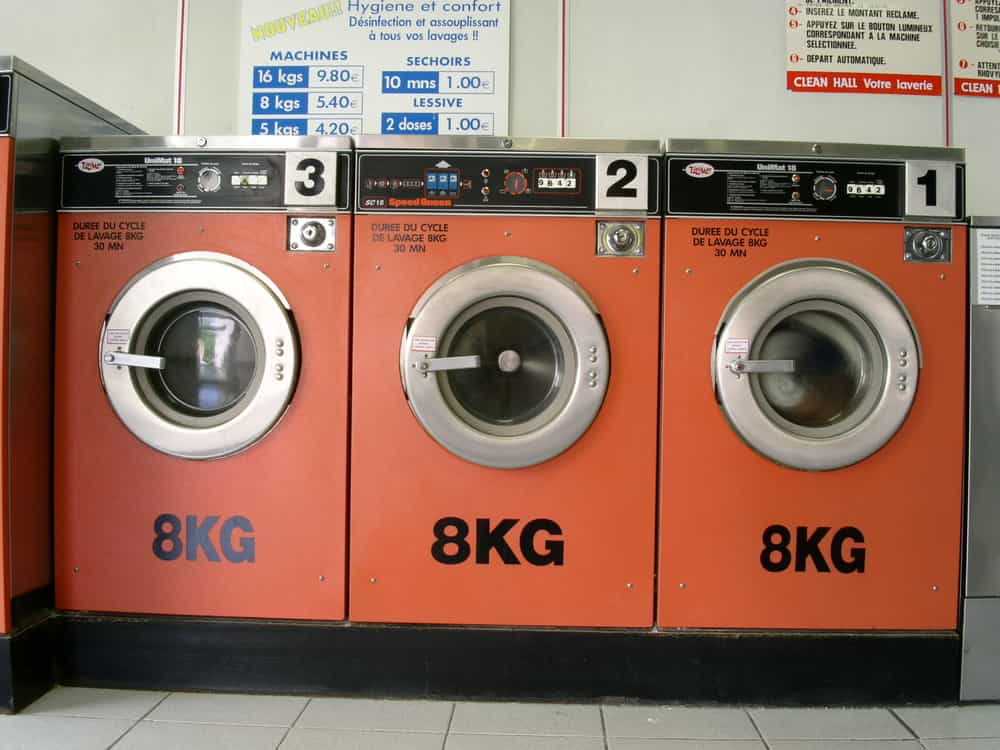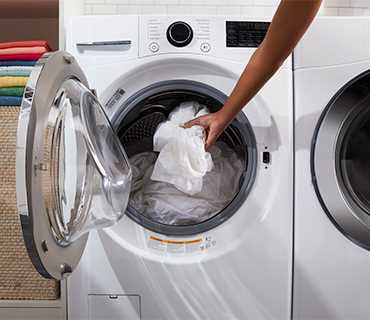




When it comes to doing laundry, one of the most common questions is how many bed sheets can fit in a washing machine. Whether you’re a new homeowner or just looking to upgrade your laundry routine, knowing the perfect laundry capacity can save you time and energy. In this article, we’ll explore the factors that determine how many bed sheets you can wash at once and provide some tips for maximizing your washing machine’s capacity.
First and foremost, it’s important to consider the size of your washing machine. The capacity of a washing machine is typically measured in kilograms, with larger machines having a higher capacity. The exact number of bed sheets that can fit in a washing machine will vary depending on the size of the sheets and the machine’s capacity. It’s also worth noting that some machines have special settings for larger or bulkier items, which can help accommodate larger loads.
Another factor to consider is the material and thickness of your bed sheets. Flannel sheets, for example, tend to be thicker and heavier than cotton sheets. This means that you may be able to fit fewer flannel sheets in your washing machine compared to cotton sheets of the same size. It’s also important to ensure that the sheets are not tightly packed in the machine, as this can prevent them from getting thoroughly cleaned.
Lastly, it’s important to consider the overall condition of your washing machine. If your machine is older or experiencing issues, it may not be able to handle the same capacity as a newer machine. Regular maintenance and upkeep can help ensure that your washing machine is operating at its full capacity and allow you to get the most out of each load.
Tip: To avoid overcrowding your washing machine, it’s recommended to only fill it up to about 80% of its capacity. This will allow the sheets to move around freely and get properly cleaned.
In conclusion, the number of bed sheets that can fit in a washing machine depends on various factors, including the size of the machine, the material and thickness of the sheets, and the overall condition of the machine. By understanding these factors and following some simple tips, you can optimize your laundry capacity and ensure that your bed sheets come out clean and fresh with each wash.
Understanding Laundry Capacity
When it comes to washing machines, capacity refers to the amount of laundry that can be loaded into the machine at one time. Understanding laundry capacity is essential for efficient and effective washing. It ensures that your clothes are thoroughly cleaned without overloading the machine.
Types of Capacity
Laundry capacity can be measured in different ways:
- Weight capacity: This refers to the maximum weight of laundry that the machine can hold. It is usually measured in kilograms (kg) or pounds (lb).
- Volume capacity: This refers to the total volume of the drum, often measured in liters (L) or cubic feet (cu ft).
- Items capacity: This refers to the number of items, such as shirts, pants, or bed sheets, that can fit in the machine at one time.
Factors Affecting Laundry Capacity

The actual laundry capacity of a washing machine may vary depending on several factors:
- Machine size: Larger washing machines generally have higher capacity than smaller ones.
- Machine type: Front-loading machines typically have larger capacity compared to top-loading machines.
- Load type: Different types of laundry, such as heavy blankets or delicate clothing, require different amounts of space in the machine.
- Machine specifications: The manufacturer’s specifications will provide the exact capacity of the machine.
Maximizing Laundry Capacity
To make the most of your washing machine’s capacity:
- Don’t overload: Avoid stuffing too many items into the machine, as this can affect the quality of the wash and strain the machine’s motor.
- Follow manufacturer’s guidelines: Always refer to the manufacturer’s guidelines for the maximum recommended load size.
- Separate your laundry: Separate your laundry by fabric type, color, and load size to optimize washing machine usage.
- Consider volume capacity: If you frequently wash bulky items like bed sheets, blankets, or curtains, choose a washing machine with a high volume capacity.
Conclusion

Understanding laundry capacity is essential for efficient and effective washing. By considering the different types of capacity, understanding the factors affecting capacity, and maximizing laundry load, you can optimize your washing machine’s performance and ensure that your clothes come out clean and fresh with each wash.
Factors to Consider
When determining how many bed sheets can fit in a washing machine, there are several factors to consider:
- Size of the washing machine: The capacity of a washing machine can vary depending on the model and brand. It’s important to check the specifications of your washing machine to determine its maximum capacity.
- Size of the bed sheets: Bed sheets come in different sizes, such as twin, full, queen, and king. The size of the bed sheets will play a role in determining how many can fit in the washing machine. Larger bed sheets will take up more space, reducing the number that can be washed at once.
- Type of fabric: The type of fabric also matters when determining how many bed sheets can fit in a washing machine. Thicker fabrics, such as flannel or heavyweight cotton, will take up more space than thinner fabrics like silk or satin.
- Other laundry items: If you plan to wash other laundry items along with the bed sheets, such as pillowcases or towels, it will reduce the number of bed sheets that can fit in the washing machine. It’s important to take into account the total amount of laundry you plan to wash to ensure everything fits comfortably in the machine.
- Agitation and spin cycles: The agitation and spin cycles of a washing machine can cause bed sheets to take up more space. It’s important to consider the potential for bed sheets to become tangled or intertwined during the wash, as this can impact how many can be washed at once.
By considering these factors, you can determine the appropriate number of bed sheets to load into your washing machine without overloading it. It’s important to follow the manufacturer’s instructions and guidelines to ensure your washing machine functions optimally and your bed sheets are cleaned effectively.
Bed Sheet Sizes
When it comes to bed sheet sizes, there are several standard dimensions to consider. The size of the bedsheet you need will depend on the size of your mattress and the depth of your mattress.
Twin Size Sheets
Twin size sheets are typically designed for a mattress that measures approximately 39 x 75 inches (99 x 190 cm) in size. These sheets are commonly used in children’s bedrooms, dorm rooms, and guest rooms.
Twin XL Size Sheets

Twin XL size sheets are similar to twin size sheets in width, measuring around 39 inches (99 cm). However, they are longer in length to fit a mattress that measures approximately 39 x 80 inches (99 x 203 cm). Twin XL sheets are commonly used in college dorm rooms.
Full Size Sheets
Full size sheets, also known as double size sheets, are designed for a mattress that measures approximately 54 x 75 inches (137 x 190 cm). These sheets offer a bit more room compared to twin size sheets and are commonly used in guest rooms.
Queen Size Sheets
Queen size sheets are designed for a mattress that measures approximately 60 x 80 inches (152 x 203 cm). These sheets are a popular choice for couples and provide more space compared to full size sheets.
King Size Sheets

King size sheets are designed for a mattress that measures approximately 76 x 80 inches (193 x 203 cm). These sheets are larger and provide ample space for couples who prefer extra room while sleeping.
California King Size Sheets
California king size sheets are designed for a mattress that measures approximately 72 x 84 inches (183 x 213 cm). These sheets are longer and narrower compared to king size sheets and are popular in larger master bedrooms.
Keep in mind that these dimensions may vary slightly depending on the brand and the country you are in. It’s always a good idea to measure your mattress and check the manufacturer’s specifications to ensure you get the right size sheets for your bed.
Choosing the Right Washing Machine
When it comes to selecting a washing machine, there are several factors to consider. The right washing machine can make a big difference in terms of convenience, efficiency, and performance. Here are some key factors to consider when choosing the right washing machine for your needs:
Type of Washing Machine
There are different types of washing machines available in the market, including top-loading and front-loading machines. Top-loading machines are typically more affordable and easier to load and unload, while front-loading machines are known for their energy efficiency and better cleaning performance.
Capacity

The capacity of a washing machine determines how much laundry it can hold in a single cycle. It is essential to choose a washing machine with an appropriate capacity for your needs. Consider the size of your household and the amount of laundry you typically do. If you have a big family or frequently wash bulky items like comforters or bed sheets, a larger capacity machine would be more suitable.
Energy Efficiency
Energy-efficient washing machines can help save both energy and money in the long run. Look for washing machines with a high Energy Star rating, which indicates that they meet specific energy-saving standards. These machines often use less water and electricity, making them more environmentally friendly.
Features

Consider the features that are important to you. Some washing machines come with specialized modes for different types of fabric or stains, while others have smart features that allow you to control the machine remotely from your smartphone. Take some time to research the available features and choose the ones that align with your specific laundry needs.
Price
Last but not least, consider your budget. Washing machines come in a wide range of prices, so it’s important to set a budget and stick to it. While it may be tempting to go for the cheapest option, investing a bit more in a quality machine can pay off in terms of durability, efficiency, and overall performance.
By considering these factors and doing your research, you can choose the right washing machine that meets your specific needs and helps make your laundry routine more efficient and convenient.
Optimizing Laundry Efficiency
1. Sort your laundry
To optimize laundry efficiency, it is important to sort your laundry before washing. This helps you categorize your clothes based on their fabric type, color, and level of dirtiness.
Fabric type: Sort your laundry into different piles based on the fabric type, such as delicates, cotton, synthetic, and jeans. This ensures that each load receives the appropriate wash cycle and protects delicate fabrics from damage.
Color: Separate your clothes into color groups, such as whites, lights, and darks. This prevents color bleeding and fading, keeping your clothes looking vibrant and fresh.
Dirtiness level: If some clothes are heavily stained or dirtied, it might be beneficial to pre-treat them or run a separate wash cycle. This ensures that all your clothes are cleaned effectively.
2. Use the appropriate wash cycle

Choosing the correct wash cycle for your laundry load helps optimize both efficiency and cleanliness.
Normal cycle: This cycle is suitable for everyday clothes that are not heavily soiled.
Delicate or gentle cycle: Use this cycle for delicate fabrics or clothes that require gentle washing.
Heavy-duty cycle: For heavily soiled items or large bedding like bed sheets, a heavy-duty cycle will provide a thorough cleaning.
3. Make use of the appropriate water level
Using the correct water level for your laundry load helps reduce both water waste and energy consumption.
Small load: When washing a small load, use the appropriate water level setting to avoid overusing water.
Large load: For larger loads, use the appropriate water level setting to ensure all clothes are evenly washed.
4. Use cold water when appropriate
Using cold water instead of hot water when appropriate can help save energy and prevent color fading. Cold water is suitable for most clothes, unless they are heavily soiled or require hot water for effective cleaning.
5. Load the washing machine efficiently

To avoid overloading the washing machine, follow these tips:
- Leave enough space for water and detergent to effectively clean your clothes.
- Do not overload the machine to prevent potential damage to the drum or motor.
- Ensure that clothes are evenly distributed to avoid an unbalanced load.
6. Consider using eco-friendly laundry detergents
Using eco-friendly laundry detergents not only helps minimize the environmental impact but also ensures that your clothes are free from harsh chemicals. These detergents are typically biodegradable and less harmful to the environment.
7. Properly maintain and clean your washing machine
To ensure optimal laundry efficiency, it is essential to regularly clean and maintain your washing machine:
- Follow the manufacturer’s guidelines for cleaning and maintenance.
- Regularly clean the detergent drawer and door seal to prevent mold and mildew buildup.
- Run cleaning cycles using vinegar or specialized washing machine cleaners to remove any residue or odors.
- Check and clean the filter regularly to prevent blockages.
8. Efficient drying methods
After washing your clothes, consider efficient drying methods:
- Air drying: Hang clothes on a clothesline or drying rack to naturally dry.
- Tumble drying: Use a dryer with a moisture sensor to prevent over-drying and conserve energy.
By following these tips, you can optimize laundry efficiency, reduce energy consumption, and ensure that your clothes are cleaned effectively.
FAQ
What is the perfect laundry capacity for a washing machine?
The perfect laundry capacity for a washing machine depends on the size of the machine. It is generally recommended to not overload the machine and leave some space for the clothes to move around during the wash cycle. For a standard-sized washing machine, a load of around 7 to 8 kilograms is considered ideal.
Can I wash bed sheets in a washing machine?
Yes, you can definitely wash bed sheets in a washing machine. Just make sure to follow the care instructions on the sheets, especially in terms of water temperature and detergent. It’s also important to not overload the machine and give enough space for the sheets to move freely during the wash cycle.
How many bed sheets can fit in a standard-sized washing machine?
The number of bed sheets that can fit in a standard-sized washing machine depends on the size and thickness of the sheets. On average, you can fit around 2 to 4 bed sheets in a single load. However, it’s best to not overload the machine and leave some space for the sheets to move around during the wash cycle.
What should I do if my washing machine is not big enough to fit all my bed sheets?
If your washing machine is not big enough to fit all your bed sheets, you have a few options. You can either wash the sheets in multiple smaller loads, or consider taking them to a laundromat with larger machines. Another option is to wash them by hand, although this can be time-consuming and labor-intensive.
Is it okay to wash bed sheets together with other clothes?
Yes, it is generally okay to wash bed sheets together with other clothes, as long as they are compatible in terms of fabric and color. However, it’s important to not overload the machine and to separate items that may cause damage, such as clothes with zippers or buttons that may snag the sheets.
What is the capacity of a standard washing machine?
A standard washing machine typically has a capacity of around 8 to 12 pounds, or approximately 3 to 4 bed sheets.














